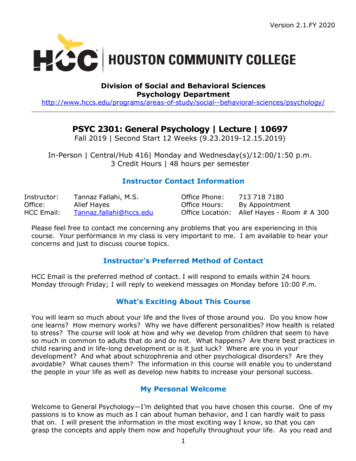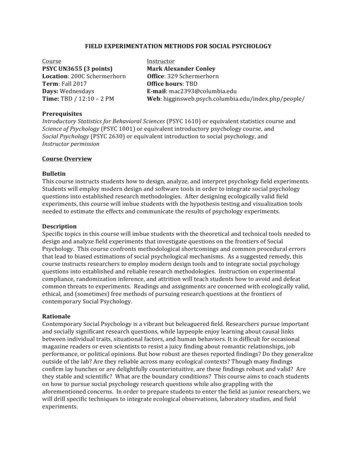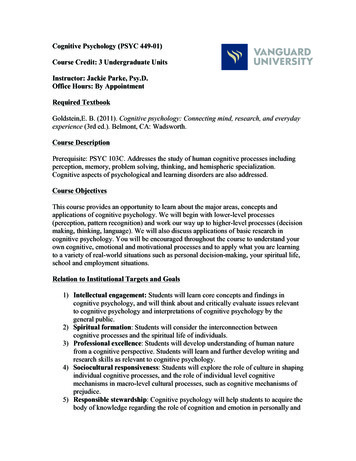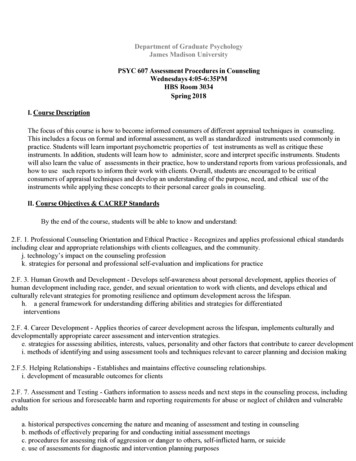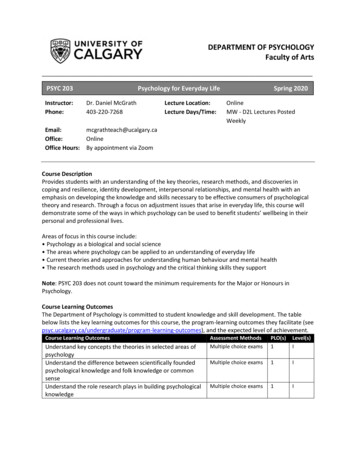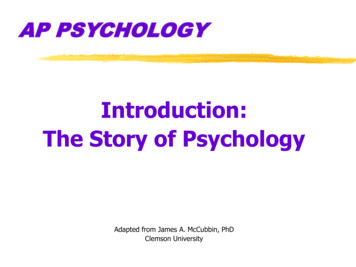
Transcription
PSYC 1100: Introductionto Psychology IDr Rajiv JhangianiNOBA
CopyrightR. Biswas-Diener & E. Diener (Eds), Noba Textbook Series: Psychology. Champaign, IL: DEFPublishers. DOI: nobaproject.comCopyright 2016 by Diener Education Fund. This material is licensed under the CreativeCommons Attribution-NonCommercial-ShareAlike 4.0 International License. To view a copyof this license, visit eed.en US.The Internet addresses listed in the text were accurate at the time of publication. The inclusionof a Website does not indicate an endorsement by the authors or the Diener Education Fund,and the Diener Education Fund does not guarantee the accuracy of the information presentedat these sites.Contact Information:Noba Project2100 SE Lake Rd., Suite 5Milwaukie, OR 97222www.nobaproject.cominfo@nobaproject.com
ContentsAbout Noba & Acknowledgements4Foundations in Psychological Science51History of Psychology6David B. Baker & Heather Sperry2Research Designs22Christie Napa Scollon3The Brain and Nervous System38Robert Biswas-DienerThinking, Learning, & Memory534Conditioning and Learning54Mark E. Bouton5Memory (Encoding, Storage, Retrieval)80Kathleen B. McDermott & Henry L. Roediger6Judgment and Decision Making103Max H. BazermanEvolution, Perception, & Consciousness1177The Nature-Nurture Question118Eric Turkheimer8Sensation and Perception131Adam John Privitera9States of Consciousness156Robert Biswas-Diener & Jake TeenyIndex176
About NobaThe Diener Education Fund (DEF) is a non-profit organization founded with the mission of reinventing higher education to serve the changing needs of students and professors. The initialfocus of the DEF is on making information, especially of the type found in textbooks, widelyavailable to people of all backgrounds. This mission is embodied in the Noba project.Noba is an open and free online platform that provides high-quality, flexibly structuredtextbooks and educational materials. The goals of Noba are three-fold: To reduce financial burden on students by providing access to free educational contentTo provide instructors with a platform to customize educational content to better suit theircurriculum To present material written by a collection of experts and authorities in the fieldThe Diener Education Fund is co-founded by Drs. Ed and Carol Diener. Ed is the Joseph SmileyDistinguished Professor of Psychology (Emeritus) at the University of Illinois. Carol Diener isthe former director of the Mental Health Worker and the Juvenile Justice Programs at theUniversity of Illinois. Both Ed and Carol are award- winning university teachers.AcknowledgementsThe Diener Education Fund would like to acknowledge the following individuals and companiesfor their contribution to the Noba Project: The staff of Positive Acorn, including Robert BiswasDiener as managing editor and Peter Lindberg as Project Manager; The Other Firm for userexperience design and web development; Sockeye Creative for their work on brand andidentity development; Arthur Mount for illustrations; Chad Hurst for photography; EEICommunications for manuscript proofreading; Marissa Diener, Shigehiro Oishi, DanielSimons, Robert Levine, Lorin Lachs and Thomas Sander for their feedback and suggestionsin the early stages of the project.
Foundations in Psychological Science
1History of PsychologyDavid B. Baker & Heather SperryThis module provides an introduction and overview of the historical development of thescience and practice of psychology in America. Ever-increasing specialization within the fieldoften makes it difficult to discern the common roots from which the field of psychology hasevolved. By exploring this shared past, students will be better able to understand howpsychology has developed into the discipline we know today.Learning Objectives Describe the precursors to the establishment of the science of psychology.Identify key individuals and events in the history of American psychology.Describe the rise of professional psychology in America.Develop a basic understandingRecognize the role of womenof the processes of scientific development and change.and people of color in the history of American psychology.IntroductionIt is always a difficult question to ask, where to begin to tell the story of the history ofpsychology. Some would start with ancient Greece; others would look to a demarcation in thelate 19th century when the science of psychology was formally proposed and instituted. Thesetwo perspectives, and all that is in between, are appropriate for describing a history ofpsychology. The interested student will have no trouble finding an abundance of resourceson all of these time frames and perspectives (Goodwin, 2011; Leahey, 2012; Schultz & Schultz,
6History of Psychology2007). For the purposes of this module, we will examinethe development of psychology in America and use themid-19th century as our starting point. For the sake ofconvenience, we refer to this as a history of modernpsychology.Psychology is an exciting field and the history ofpsychology offers the opportunity to make sense of howit has grown and developed. The history of psychologyalso provides perspective. Rather than a dry collectionof names and dates, the history of psychology tells usabout the important intersection of time and place thatdefines who we are. Consider what happens when youmeet someone for the first time. The conversationThe earliest records of a psychologicalusually begins with a series of questions such as, “Whereexperiment go all the way back to the Pharaohdid you grow up?” “How long have you lived here?”Psamtik I of Egypt in the 7th Century B.C.“Where did you go to school?” The importance of history[Image: Neithsabes]in defining who we are cannot be understated. Whetheryou are seeing a physician, talking with a counselor, orapplying for a job, everything begins with a history. The same is true for studying the historyof psychology; getting a history of the field helps to make sense of where we are and how wegot here.A Prehistory of PsychologyPrecursors to American psychology can be found in philosophy and physiology. Philosopherssuch as John Locke (1632–1704) and Thomas Reid (1710–1796) promoted empiricism, theidea that all knowledge comes from experience. The work of Locke, Reid, and othersemphasized the role of the human observer and the primacy of the senses in defining howthe mind comes to acquire knowledge. In American colleges and universities in the early1800s, these principles were taught as courses on mental and moral philosophy. Most oftenthese courses taught about the mind based on the faculties of intellect, will, and the senses(Fuchs, 2000).Physiology and PsychophysicsPhilosophical questions about the nature of mind and knowledge were matched in the 19thcentury by physiological investigations of the sensory systems of the human observer. German
History of Psychology7physiologist Hermann von Helmholtz (1821–1894) measured the speed of the neural impulseand explored the physiology of hearing and vision. His work indicated that our senses candeceive us and are not a mirror of the external world. Such work showed that even thoughthe human senses were fallible, the mind could be measured using the methods of science.In all, it suggested that a science of psychology was feasible.An important implication of Helmholtz’s work was that there is a psychological reality and aphysical reality and that the two are not identical. This was not a new idea; philosophers likeJohn Locke had written extensively on the topic, and in the 19th century, philosophicalspeculation about the nature of mind became subject to the rigors of science.The question of the relationship between the mental (experiences of the senses) and thematerial (external reality) was investigated by a number of German researchers includingErnst Weber and Gustav Fechner. Their work was called psychophysics, and it introducedmethods for measuring the relationship between physical stimuli and human perception thatwould serve as the basis for the new science of psychology (Fancher & Rutherford, 2011).The formal development of modern psychology is usually credited to the work of Germanphysician, physiologist, and philosopher Wilhelm Wundt (1832–1920). Wundt helped toestablish the field of experimental psychology by serving as a strong promoter of the ideathat psychology could be an experimental field and by providing classes, textbooks, and alaboratory for training students. In 1875, he joined the faculty at the University of Leipzig andquickly began to make plans for the creation of a program of experimental psychology. In1879, he complemented his lectures on experimental psychology with a laboratoryexperience: an event that has served as the popular date for the establishment of the scienceof psychology.The response to the new science was immediate and global. Wundt attracted students fromaround the world to study the new experimental psychology and work in his lab. Studentswere trained to offer detailed self-reports of their reactions to various stimuli, a procedureknown as introspection. The goal was to identify the elements of consciousness. In additionto the study of sensation and perception, research was done on mental chronometry, morecommonly known as reaction time. The work of Wundt and his students demonstrated thatthe mind could be measured and the nature of consciousness could be revealed throughscientific means. It was an exciting proposition, and one that found great interest in America.After the opening of Wundt’s lab in 1879, it took just four years for the first psychologylaboratory to open in the United States (Benjamin, 2007).Scientific Psychology Comes to the United States
8History of PsychologyWundt’s version of psychology arrived in America most visibly through the work of EdwardBradford Titchener (1867–1927). A student of Wundt’s, Titchener brought to America a brandof experimental psychology referred to as “structuralism.” Structuralists were interested inthe contents of the mind—what the mind is. For Titchener, the general adult mind was theproper focus for the new psychology, and he excluded from study those with mentaldeficiencies, children, and animals (Evans, 1972; Titchener, 1909).Experimental psychology spread rather rapidly throughout North America. By 1900, therewere more than 40 laboratories in the United States and Canada (Benjamin, 2000). Psychologyin America also organized early with the establishment of the American PsychologicalAssociation (APA) in 1892. Titchener felt that this new organization did not adequatelyrepresent the interests of experimental psychology, so, in 1904, he organized a group ofcolleagues to create what is now known as the Society of Experimental Psychologists (Goodwin,1985). The group met annually to discuss research in experimental psychology. Reflecting thetimes, women researchers were not invited (or welcome). It is interesting to note thatTitchener’s first doctoral student was a woman, Margaret Floy Washburn (1871–1939). Despitemany barriers, in 1894, Washburn became the first woman in America to earn a Ph.D. inpsychology and, in 1921, only the second woman to be elected president of the AmericanPsychological Association (Scarborough & Furumoto, 1987).Striking a balance between the science and practice of psychology continues to this day. In1988, the American Psychological Society (now known as the Association for PsychologicalScience) was founded with the central mission of advancing psychological science.Toward a Functional PsychologyWhile Titchener and his followers adhered to a structural psychology, others in America werepursuing different approaches. William James, G. Stanley Hall, and James McKeen Cattell wereamong a group that became identified with “functionalism.” Influenced by Darwin’sevolutionary theory, functionalists were interested in the activities of the mind—what themind does. An interest in functionalism opened the way for the study of a wide range ofapproaches, including animal and comparative psychology (Benjamin, 2007).William James (1842–1910) is regarded as writing perhaps the most influential and importantbook in the field of psychology, Principles of Psychology, published in 1890. Opposed to thereductionist ideas of Titchener, James proposed that consciousness is ongoing andcontinuous; it cannot be isolated and reduced to elements. For James, consciousness helpedus adapt to our environment in such ways as allowing us to make choices and have personal
9History of Psychologyresponsibility over those choices.At Harvard, James occupied a position of authority and respect in psychology and philosophy.Through his teaching and writing, he influenced psychology for generations. One of hisstudents, Mary Whiton Calkins (1863–1930), faced many of the challenges that confrontedMargaret Floy Washburn and other women interested in pursuing graduate education inpsychology. With much persistence, Calkins was able to study with James at Harvard. Sheeventually completed all the requirements for the doctoral degree, but Harvard refused togrant her a diploma because she was a woman. Despite these challenges, Calkins went on tobecome an accomplished researcher and the first woman elected president of the AmericanPsychological Association in 1905 (Scarborough & Furumoto, 1987).G. Stanley Hall (1844–1924) made substantial and lasting contributions to the establishmentof psychology in the United States. At Johns Hopkins University, he founded the firstpsychological laboratory in America in 1883. In 1887, he created the first journal of psychologyin America, American Journal of Psychology. In 1892, he founded the American PsychologicalAssociation (APA); in 1909, he invited and hosted Freud at Clark University (the only time Freudvisited America). Influenced by evolutionary theory, Hall was interested in the process ofadaptation and human development. Using surveys and questionnaires to study children,Hall wrote extensively on child development and education. While graduate education inpsychology was restricted for women in Hall’s time, it was all but non-existent for AfricanAmericans. In another first, Hall mentored Francis Cecil Sumner (1895–1954) who, in 1920,became the first African American to earn a Ph.D. in psychology in America (Guthrie, 2003).James McKeen Cattell (1860–1944) received his Ph.D. with Wundt but quickly turned hisinterests to the assessment of individual differences. Influenced by the work of Darwin’scousin, Frances Galton, Cattell believed that mental abilities such as intelligence were inheritedand could be measured using mental tests. Like Galton, he believed society was better servedby identifying those with superior intelligence and supported efforts to encourage them toreproduce. Such beliefs were associated with eugenics (the promotion of selective breeding)and fueled early debates about the contributions of heredity and environment in definingwho we are. At Columbia University, Cattell developed a department of psychology thatbecame world famous also promoting psychological science through advocacy and as apublisher of scientific journals and reference works (Fancher, 1987; Sokal, 1980).The Growth of PsychologyThroughout the first half of the 20th century, psychology continued to grow and flourish in
History of Psychology10America. It was large enough to accommodate varying points of view on the nature of mindand behavior. Gestalt psychology is a good example. The Gestalt movement began inGermany with the work of Max Wertheimer (1880–1943). Opposed to the reductionistapproach of Wundt’s laboratory psychology, Wertheimer and his colleagues Kurt Koffka (1886–1941), Wolfgang Kohler (1887–1967), and Kurt Lewin (1890–1947) believed that studying thewhole of any experience was richer than studying individual aspects of that experience. Thesaying “the whole is greater than the sum of its parts” is a Gestalt perspective. Consider thata melody is an additional element beyond the collection of notes that comprise it. The Gestaltpsychologists proposed that the mind often processes information simultaneously ratherthan sequentially. For instance, when you look at a photograph, you see a whole image, notjust a collection of pixels of color. Using Gestalt principles, Wertheimer and his colleaguesalso explored the nature of learning and thinking. Most of the German Gestalt psychologistswere Jewish and were forced to flee the Nazi regime due to the threats posed on both academicand personal freedoms. In America, they were able to introduce a new audience to the Gestaltperspective, demonstrating how it could be applied to perception and learning (Wertheimer,1938). In many ways, the work of the Gestalt psychologists served as a precursor to the riseof cognitive psychology in America (Benjamin, 2007).Behaviorism emerged early in the 20th century and became a major force in Americanpsychology. Championed by psychologists such as John B. Watson (1878–1958) and B. F.Skinner (1904–1990), behaviorism rejected any reference to mind and viewed overt andobservable behavior as the proper subject matter of psychology. Through the scientific studyof behavior, it was hoped that laws of learning could be derived that would promote theprediction and control of behavior. Russian physiologist Ivan Pavlov (1849–1936) influencedearly behaviorism in America. His work on conditioned learning, popularly referred to asclassical conditioning, provided support for the notion that learning and behavior werecontrolled by events in the environment and could be explained with no reference to mindor consciousness (Fancher, 1987).For decades, behaviorism dominated American psychology. By the 1960s, psychologists beganto recognize that behaviorism was unable to fully explain human behavior because it neglectedmental processes. The turn toward a cognitive psychology was not new. In the 1930s, Britishpsychologist Frederic C. Bartlett (1886–1969) explored the idea of the constructive mind,recognizing that people use their past experiences to construct frameworks in which tounderstand new experiences. Some of the major pioneers in American cognitive psychologyinclude Jerome Bruner (1915–), Roger Brown (1925–1997), and George Miller (1920–2012). Inthe 1950s, Bruner conducted pioneering studies on cognitive aspects of sensation andperception. Brown conducted original research on language and memory, coined the term“flashbulb memory,” and figured out how to study the tip-of-the-tongue phenomenon
11History of Psychology(Benjamin, 2007). Miller’s research on working memory is legendary. His 1956 paper “TheMagic Number Seven, Plus or Minus Two: Some Limits on Our Capacity for ProcessingInformation”is one of the most highly cited papers in psychology. A popular interpretation ofMiller’s research was that the number of bits of information an average human can hold inworking memory is 7 2. Around the same time, the study of computer science was growingand was used as an analogy to explore and understand how the mind works. The work ofMiller and others in the 1950s and 1960s has inspired tremendous interest in cognition andneuroscience, both of which dominate much of contemporary American psychology.Applied Psychology in AmericaIn America, there has always been an interest in the application of psychology to everydaylife. Mental testing is an important example. Modern intelligence tests were developed by theFrench psychologist Alfred Binet (1857–1911). His goal was to develop a test that would identifyschoolchildren in need of educational support. His test, which included tasks of reasoningand problem solving, was introduced in the United States by Henry Goddard (1866–1957) andlater standardized by Lewis Terman (1877–1956) at Stanford University. The assessment andmeaning of intelligence has fueled debates in American psychology and society for nearly 100years. Much of this is captured in the nature-nurture debate that raises questions about therelative contributions of heredity and environment in determining intelligence (Fancher, 1987).Applied psychology was not limited to mental testing. What psychologists were learning intheir laboratories was applied in many settings including the military, business, industry, andeducation. The early 20th century was witness to rapid advances in applied psychology. HugoMunsterberg (1863–1916) of Harvard University made contributions to such areas asemployee selection, eyewitness testimony, and psychotherapy. Walter D. Scott (1869–1955)and Harry Hollingworth (1880–1956) produced original work on the psychology of advertisingand marketing. Lillian Gilbreth (1878–1972) was a pioneer in industrial psychology andengineering psychology. Working with her husband, Frank, they promoted the use of timeand motion studies to improve efficiency in industry. Lillian also brought the efficiencymovement to the home, designing kitchens and appliances including the pop-up trashcanand refrigerator door shelving. Their psychology of efficiency also found plenty of applicationsat home with their 12 children. The experience served as the inspiration for the movie Cheaperby the Dozen (Benjamin, 2007).Clinical psychology was also an early application of experimental psychology in America.Lightner Witmer (1867–1956) received his Ph.D. in experimental psychology with WilhelmWundt and returned to the University of Pennsylvania, where he opened a psychological clinic
12History of Psychologyin 1896. Witmer believed that because psychology dealt with the study of sensation andperception, it should be of value in treating children with learning and behavioral problems.He is credited as the founder of both clinical and school psychology (Benjamin & Baker, 2004).Psychology as a ProfessionAs the roles of psychologists and the needs of the public continued to change, it was necessaryfor psychology to begin to define itself as a profession. Without standards for training andpractice, anyone could use the title psychologist and offer services to the public. As early as1917, applied psychologists organized to create standards for education, training, andlicensure. By the 1930s, these efforts led to the creation of the American Association forApplied Psychology (AAAP). While the American Psychological Association (APA) representedthe interests of academic psychologists, AAAP served those in education, industry, consulting,and clinical work.The advent of WWII changed everything. The psychiatric casualties of war were staggering,and there were simply not enough mental health professionals to meet the need. Recognizingthe shortage, the federal government urged the AAAP and APA to work together to meet themental health needs of the nation. The result was the merging of the AAAP and the APA anda focus on the training of professional psychologists. Through the provisions of NationalMental Health Act of 1946, funding was made available that allowed the APA, the VeteransAdministration, and the Public Health Service to work together to develop training programsthat would produce clinical psychologists. These efforts led to the convening of the BoulderConference on Graduate Education in Clinical Psychology in 1949 in Boulder, Colorado. Themeeting launched doctoral training in psychology and gave us the scientist-practitionermodel of training. Similar meetings also helped launch doctoral training programs incounseling and school psychology. Throughout the second half of the 20th century,alternatives to Boulder have been debated. In 1973, the Vail Conference on ProfessionalTraining in Psychology proposed the scholar-practitioner model and the Psy.D. degree(Doctor of Psychology). It is a training model that emphasizes clinical training and practicethat has become more common (Cautin & Baker, in press).Psychology and SocietyGiven that psychology deals with the human condition, it is not surprising that psychologistswould involve themselves in social issues. For more than a century, psychology andpsychologists have been agents of social action and change. Using the methods and tools ofscience, psychologists have challenged assumptions, stereotypes, and stigma. Founded in
13History of Psychology1936, the Society for the Psychological Study of Social Issues (SPSSI) has supported researchand action on a wide range of social issues. Individually, there have been many psychologistswhose efforts have promoted social change. Helen Thompson Woolley (1874–1947) and LetaS. Hollingworth (1886–1939) were pioneers in research on the psychology of sex differences.Working in the early 20th century, when women’s rights were marginalized, Thompsonexamined the assumption that women were overemotional compared to men and found thatemotion did not influence women’s decisions any more than it did men’s. Hollingworth foundthat menstruation did not negatively impact women’s cognitive or motor abilities. Such workcombatted harmful stereotypes and showed that psychological research could contribute tosocial change (Scarborough & Furumoto, 1987).Among the first generation of African American psychologists, Mamie Phipps Clark (1917–1983) and her husband Kenneth Clark (1914–2005) studied the psychology of race anddemonstrated the ways in which school segregation negatively impacted the self-esteem ofAfrican American children. Their research was influential in the 1954 Supreme Court ruling inthe case of Brown v. Board of Education, which ended school segregation (Guthrie, 2003). Inpsychology, greater advocacy for issues impacting the African American community wereadvanced by the creation of the Association of Black Psychologists (ABPsi) in 1968.In 1957, psychologist Evelyn Hooker (1907–1996) published the paper “The Adjustment of theMale Overt Homosexual,” reporting on her research that showed no significant differences inpsychological adjustment between homosexual and heterosexual men. Her research helpedto de-pathologize homosexuality and contributed to the decision by the American PsychiatricAssociation to remove homosexuality from the Diagnostic and Statistical Manual of MentalDisorders in 1973 (Garnets & Kimmel, 2003).ConclusionGrowth and expansion have been a constant in American psychology. In the latter part of the20th century, areas such as social, developmental, and personality psychology made majorcontributions to our understanding of what it means to be human. Today neuroscience isenjoying tremendous interest and growth.As mentioned at the beginning of the module, it is a challenge to cover all the history ofpsychology in such a short space. Errors of omission and commission are likely in such aselective review. The history of psychology helps to set a stage upon which the story ofpsychology can be told. This brief summary provides some glimpse into the depth and richcontent offered by the history of psychology. The modules in this e-book are all elaborations
14History of Psychologyon the foundation created by our shared past. It is hoped that you will be able to see theseconnections and have a greater understanding and appreciation for both the unity anddiversity of the field of psychology.Timeline1600s – Rise of empiricism emphasizing centrality of human observer in acquiring knowledge1850s - Helmholz measures neural impulse / Psychophysics studied by Weber & Fechner1859 - Publication of Darwin's Origin of Species1879 - Wundt opens lab for experimental psychology1883 - First psychology lab opens in the United States1887 – First American psychology journal is published: American Journal of Psychology1890 – James publishes Principles of Psychology1892 – APA established1894 – Margaret Floy Washburn is first U.S. woman to earn Ph.D. in psychology1904 - Founding of Titchener's experimentalists1905 - Mary Whiton Calkins is first woman president of APA1909 – Freud’s only visit to the United States1913 - John Watson calls for a psychology of behavior1920 – Francis Cecil Sumner is first African American to earn Ph.D. in psychology1921 – Margaret Floy Washburn is second woman president of APA1930s – Creation and growth of the American Association for Applied Psychology (AAAP)/ Gestalt psychology comes to America
History of Psychology151936- Founding of The Society for the Psychological Study of Social Issues1940s – Behaviorism dominates American psychology1946 – National Mental Health Act1949 – Boulder Conference on Graduate Education in Clinical Psychology1950s – Cognitive psychology gains popularity1954 – Brown v. Board of Education1957 – Evelyn Hooker publishes The Adjustment of the Male Overt Homosexual1968 – Founding of the Association of Black Psychologists1973 – Psy.D. proposed at the Vail Conference on Professional Training in Psychology1988 – Founding of the American Psychological Society (now known as the Association forPsychological Science)
16History of PsychologyOutside ResourcesPodcast: History of Psychology Podcast Serieshttp://www.yorku.ca/christo/podcasts/Web: Advances in the History of Psychologyhttp://ahp.apps01.yorku.ca/Web: Center for the History of Psychologyhttp://www.uakron.edu/chpWeb: Classics in the History of Psychologyhttp://psychclassics.yorku.ca/Web: Psychology’s Feminist Voiceshttp://www.feministvoices.com/Web: This Week in the History of cussion Questions1. Why was psychophysics important to the development of psychology as a science?2. How have psychologists participated in the advancement of social issues?3. Name some ways in which psychology began to be applied to the general public andeveryday problems.4. Describe functionalism and structuralism and their influences on behaviorism andcognitive psychology.
17History of PsychologyVocabularyBehaviorismThe study of behavior.Cognitive psychologyThe study of mental processes.ConsciousnessAwareness of ourselves and our environment.Empiricism
the development of psychology in America and use the mid-19th century as our starting point. For the sake of convenience, we refer to this as a history of modern psychology. Psychology is an exciting field and the history of psychology offers the opportunity to make sense of how it has grown

